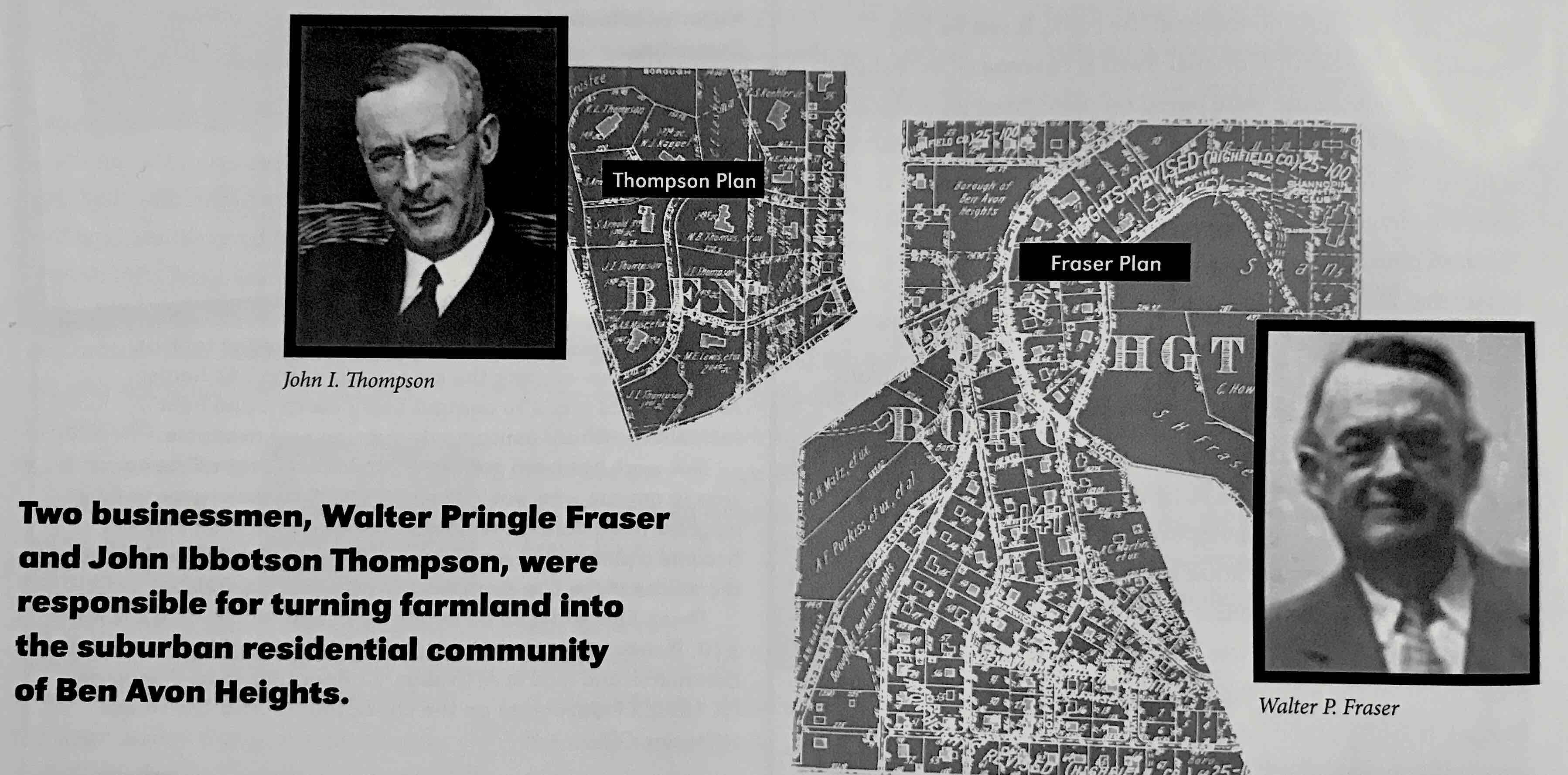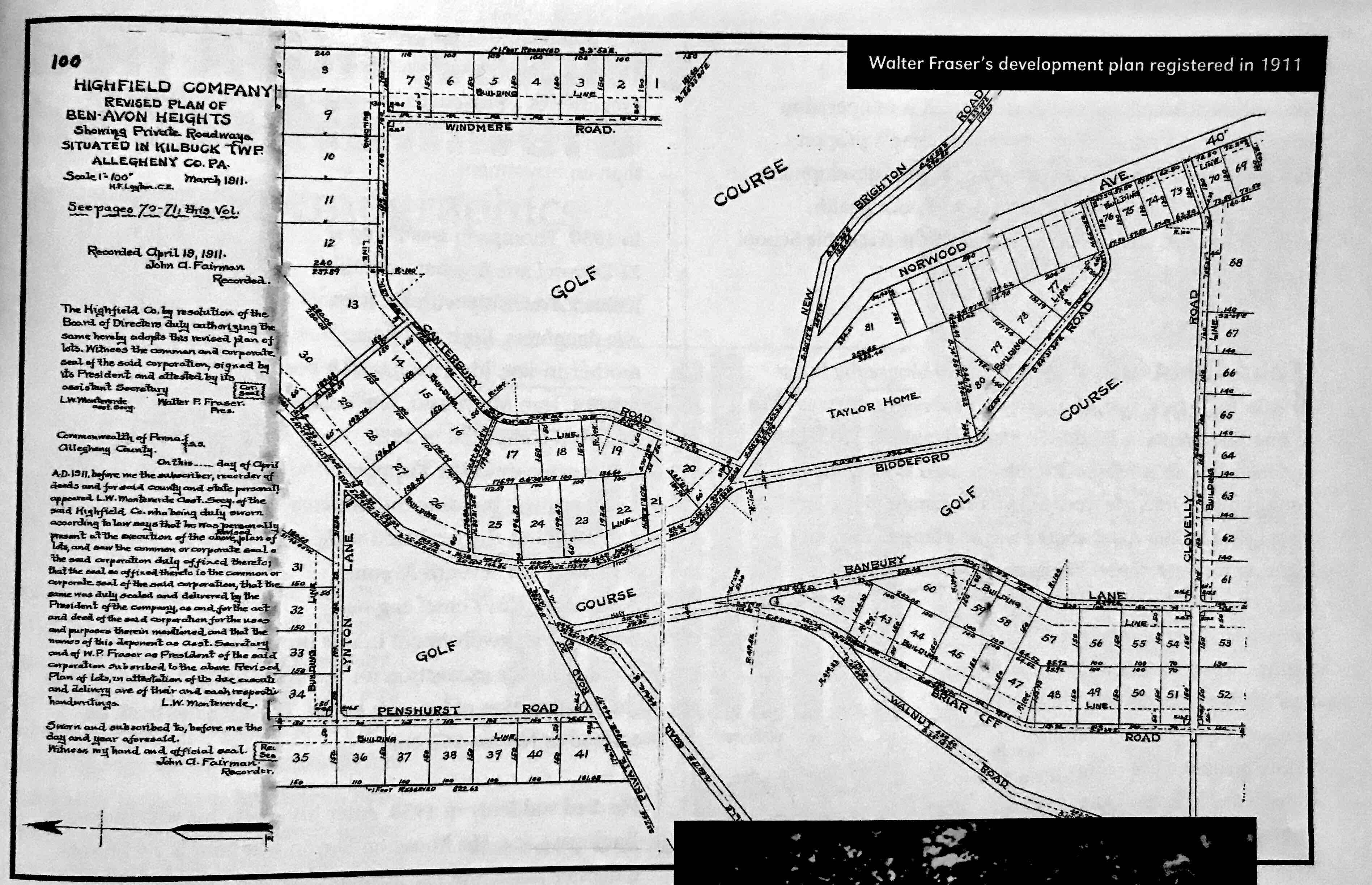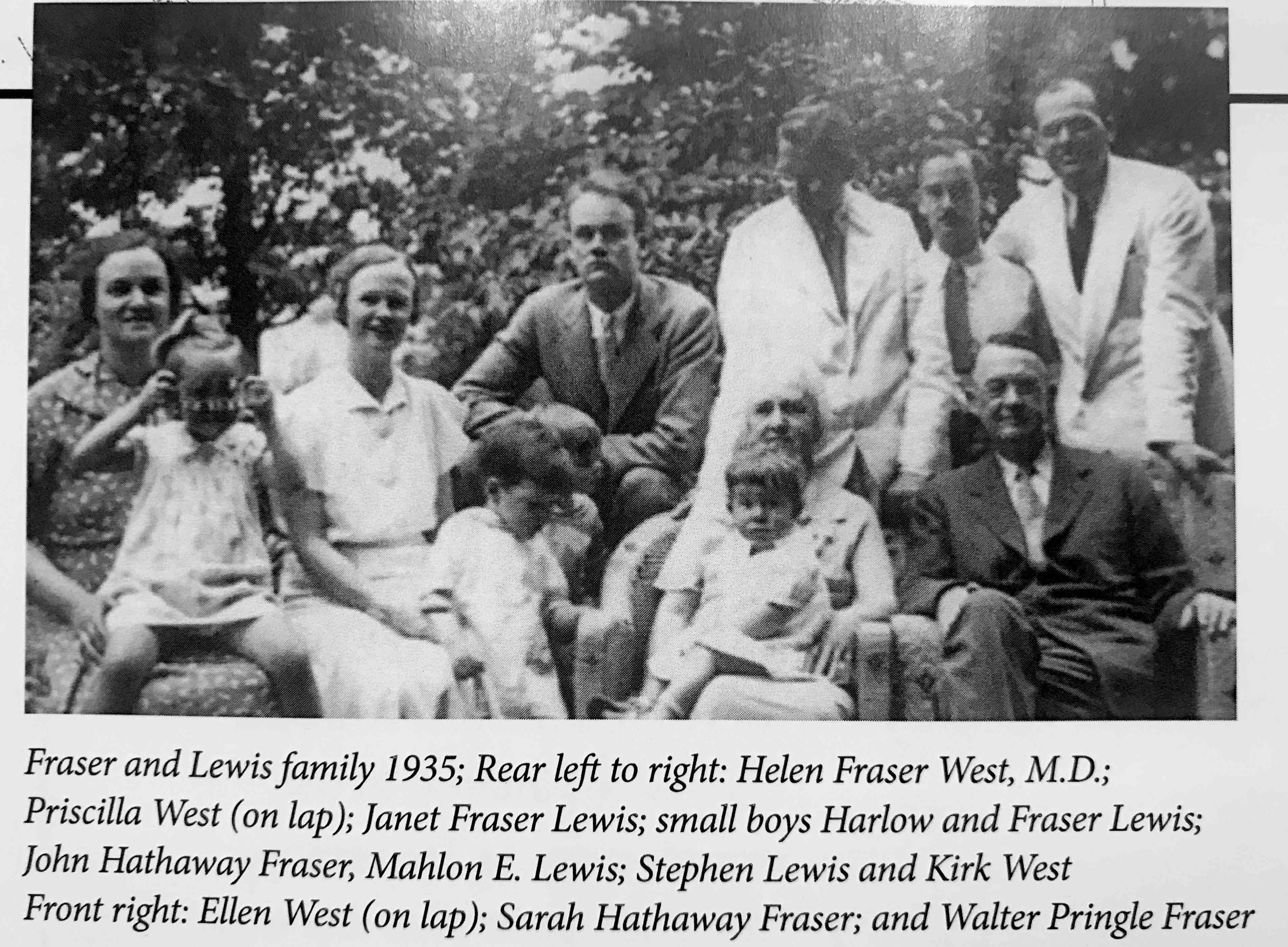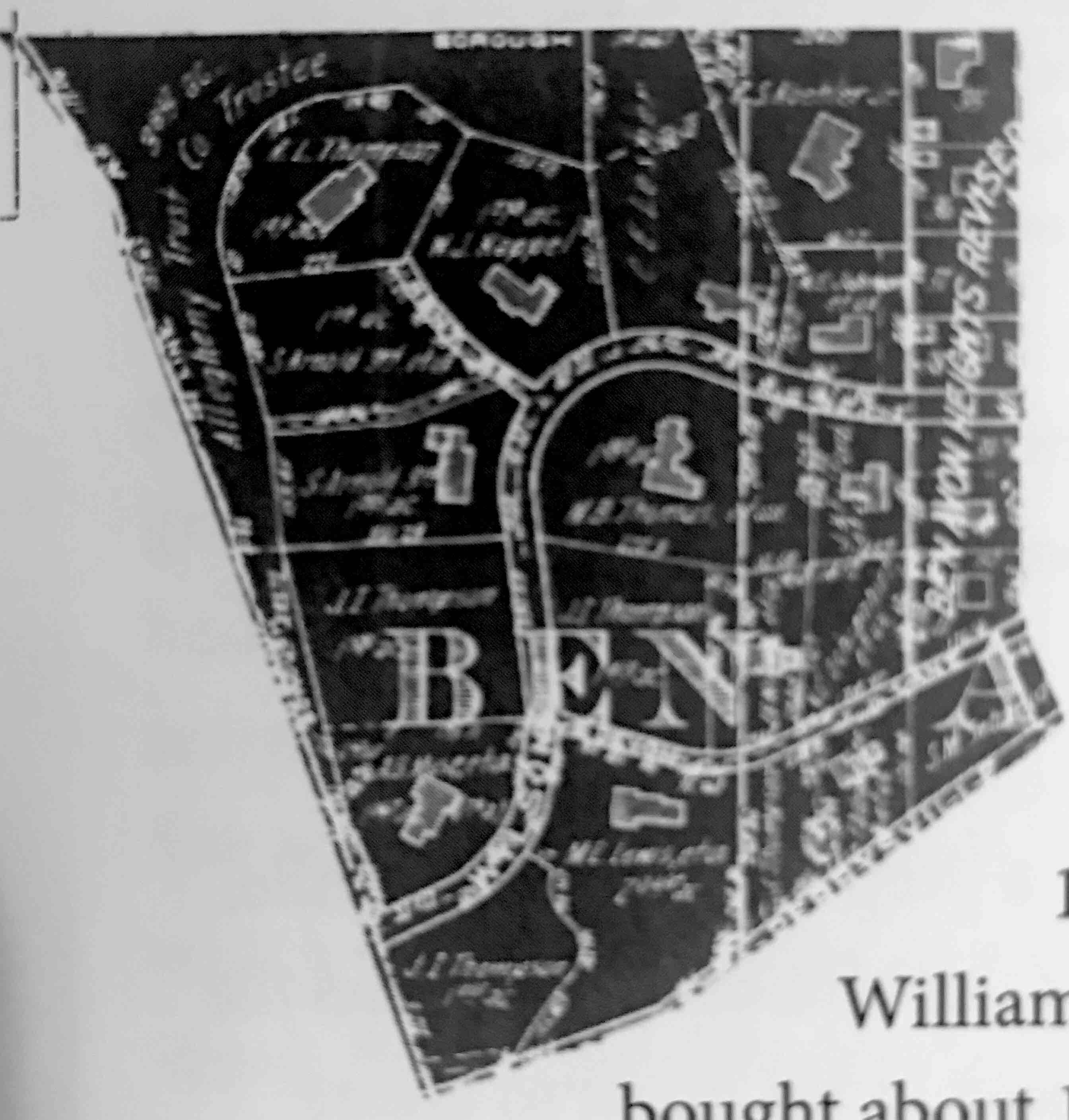Ben Avon Heights Borough ... Two Men, Two Plans, One Community
Two businessmen, Walter Pringle Fraser and John Ibbotson Thompson, were responsible for turning farmland into the suburban residential community of Ben Avon Heights.

Fraser Plan
Walter Pringle Fraser was born in 1872 in Allegheny County, now a part of the city of Pittsburgh. He eventually moved to Bonnie Brae, a large house he built at the corner of Dickson and Perrysville Avenues in Ben Avon. He was a developer in Brighton Heights and Morewood Heights in Pittsburgh as well as Ben Avon Heights. He married Sarah Hathaway. They had four children, a daughter Janet who later married Mahlon E. Lewis, a second daughter Helen, and two sons, John and Stephen. Fraser died in 1936.
In 1910, Fraser bought eighty three acres from Samuel Taylor and his wife Agnes for $55,000. Taylor's grandfather, John Taylor, had settled on the land around 1800. Taylor kept a few acres around his house which stands at 9 Oxford Road. Fraser quickly divided his purchase into 81 building lots and Ben Avon Country Club. This became the Ben Avon Heights Plan of lots. Nine of the lots were on Norwood Avenue and eventually dropped from the plan. The revised plan of lots was recorded with the county in 1911. The golf course was not successful. It closed in 1917, making way for the Shannopin Country Club. In 1926 Fraser subdivided the course adding 33 more lots. In 1933, the land in his plan was incorporated as the Borough of Ben Avon Heights.

Fraser began to sell the lots in 1910. He hired an architect, Earl DeForest Stonerod, to design houses. By early 1911, Fraser had begun to build houses on some of the lots with “nifty effects in stone and shingle cottages in Ben Avon Heights.”
Fraser brought more than houses to Ben Avon Heights. He was described by William Neely, a resident of Ben Avon Heights, as bringing to the Borough “an aura of high morals”. He may not have entirely successful in this. Another later resident, Norman Ward, suggested that the first golf course failed because there was no Sunday golf or alcohol on the course.
Fraser's faith led him to take an active interest in the community. He served as the Chairman of the Woods Run Relief Committee and was active in the Associated Charities of Pittsburgh. He was one of the Founders of Suburban General Hospital. He was described by Neely as generous with his contributions. He also founded the Christian Laymen's Association of Pittsburgh. He served as its General Secretary. The motto of the Laymen's Association of Pittsburgh was “a yielded will, the power of prayer, the morning watch and witnessing for Christ daily.” The Christian Laymen's Association national movement with Associations in a number of cities. The Laymen's Association in Pittsburgh began with a group of men forming a fellowship for Bible study, leadership training and recreation. The Association began with meetings at the downtown YMCA. Fraser had built a conference hall and clay tennis courts on Stratford Road as part of his development. In 1926, Fraser transferred the hall to the Association with a provision that allowed him to take back the property in five years. In addition to serving the Association, the hall was rented by the Borough for Council meetings and as a polling place.

He wrote a book, Life Principals or the Science of Human Nature, which was published by the Laymen's Association in 1924. In it, he promotes "Practical Imagination," the ability to separate cause from effect, or impressions from facts. He credits Jesus Christ and Sigmund Freud, "the Columbus of the mind," as his inspiration.
Fraser had ties to a number of educational institutions. Fraser sold five lots along New Brighton Road to Muskingum College in 1917 for $1.00. He served on the Board of Trustees of Wheaton College for a term that ended in 1931. His daughter, Janet, earned a Bachelor of Science degree from Wheaton in 1929.
In 1926, he bought the Asheville School, a prep school in Asheville, North Carolina. He changed the name of the school to the Asheville School for Training in Christian Leadership in his quest to create a theological seminary. He was also interested in the land owned by the school for development. The relationship between Fraser and the school's staff was not a smooth one. He fired several faculty members who resisted the change in mission at the school. In 1928, the school's headmaster proposed that the school's alumni should buy the school. In 1929, Fraser offered to sell it for $600,000. The sale was completed in 1930. The school survived the turmoil and the depression. It is in operation today. Fraser did not develop any of the school's property. Fraser became less active in Ben Avon Heights development by the end of the 1920s. A combination of poor health, business reverses and the difficulties with the Asheville School may have contributed to this.
Thompson Plan

John Ibbotson Thompson’s biography is less colorful than Fraser's, but no less impressive. He was born to English parents in Braddock, Pennsylvania in 1883. He and his wife Osa Adelaide Thompson lived for a while in Youngstown, Ohio. He worked as a draftsman. By 1919, they were living in Ben Avon and he was working as the chief engineer for the Koppers Company. The Koppers Company at that time specialized in turing carbon coal tar. He was active in Ben Avon Heights before be built a house for himself at 21 Devon. Thompson was one founding members and president of the Shannopin Country Club.
Beginning in 1926, son and a partner, Samuel Johnston, bought five parcels of land to the west of Penhurst in Kilbuck Township and divided them into building lots. Most of the land had been part of the Wilson farm. By 1930, Johnston had moved to Phoenix, Arizona. He sold his interest in the development to Thompson. The Thompson plan lots were considerably larger than the lots in the Fraser plan.
The Wilson farm had been settled by William Dickson in 1789. In 1864, three brothers, William, John and Alexander Wilson, bought about 140 acres from Dickson's grandson. The brothers were in the livery business in Allegheny City and needed pasture for horses. They did not settle on the land until William's son Nelson built a home in 1905. The house still stands at the corner of Wilson Drive and Newgate Road.
R. S. Koehler, the grandson of one of the purchasers of the Thompson plan lots, described Thompson as "a wealthy executive of a Pittsburgh manufacturing corporation and [who] had developed the land more in the vein of a hobby than an investment."
In 1930, Thompson was living at 21 Devon Lane in what was still Kilbuck Township with his wife, two daughters, Ruth and Jane, mother-in-law, Ida Tilson, and a servant, Jean Machinski. lhe house had been completed in 1929. At the same time, the Koppers Company was building the Koppers Building, the Art Deco-style skyscraper on Seventh Avenue. As the company's chief engineer, he had some involvement in this project. Stone from the excavation for the office building was used in the construction of his own home. The style has been described as Norman Gothic.
He died suddenly in 1938. After his death, his wife moved to Banbury Lane. His house on Devon was bought by Fraser's daughter Janet, and her husband Mahlon Lewis.
The Plan completed the division of the land into residential building lots on Wilson Drive, Devon Lane, and Kent Road. In 1936, the Borough annexed the Thompson Plan. By the 2010 census, the Borough included 142 houses, a community park, and the club house of the Shannopin Country Club.